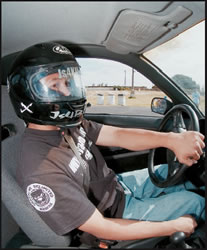Getting Sideways
It’s called drifting, a rather tame term for putting a speeding car into a slide, and it’s growing in popularity at the Hawaii Motorsports Center

By .(JavaScript must be enabled to view this email address)
E-mail this story | Print this page | Archive | RSS
the Japan drifters, so we had an idea of what it was like. But those drivers (in the videos) are really good, and down at the track (on the beginner’s side) these guys are so green and you realize that it’s going to take a lot of practice before they get to that point.”
Jason and his wife, Maureen, believe that it’s important for parents to be supportive of their children’s hobbies. And by watching their boys in action, they were able to understand what goes on during these activities.
“Drifting is something that is going to keep them occupied and hopefully it’s going to keep them away from other things like drinking and the drug scene,” says Jason. “And they’re learning a lot from working on the cars. A week before the Drift Session they took out three motors and three rear ends to put into other cars. They were into go-peds and mopeds before, and they would take them apart, fix it and sell it. And from that they were able to make money and pretty much bought the cars they have now on their own.

Gary Ganotisi takes it slow and easy
on the photographer
“It’s good to know what they’re doing and that the area that they’re doing it in is safe. I’d rather give them money to go somewhere like the track, where it’s controlled, vs. on the road. Also, our daughter ,who is 19, is now talking about wanting to get a car and wants to start going down there too.”
Drifting is believed to have started over 20 years ago through the winding mountain roads of Japan.
“Illegal racers would race up and down the mountain passes in the middle of the night with highly modified street vehicles,” explains Shimokawa. “Since they were racing as fast as they possibly could, occasionally a racer would find himself pushing his vehicle past its traction limits in a corner, causing the car to slip and skid. Some racers would lose control of their vehicles and crash; others had the skill to recover from skidding traction loss and eventually learned to control the sliding motion.
“Racers quickly learned that being able to forcibly cause their vehicle to slide across the roadway was a crowd-pleasing maneuver. Controlling the ‘drift’ soon became the ultimate expression of car-control and a maneuver only used by the super-cool drivers.”
In Hawaii, drifting is said to have started about 10 years ago by a handful of drivers who would illegally speed up and down various winding roads on Oahu.
Then in July 2001, Drift Session began, offering local drift enthusiasts a safe, controlled and legal place to practice the fast-growing sport. The first season of events on Oahu was also the first event series and competition for drifting outside of Japan.
“In 2002, we were the first organization in the United States to bring a professional Japanese drifter and pro drift vehicle to America,” says Shimokawa. “The publicity generated by that single event created a virtual drifting frenzy across the entire U.S., making drifting the new buzzword of the automotive industry.”
Steve Oliberos, who owns an auto shop specializing in Nissan performance vehicles, learned about drifting through his younger customers who were doing it. He decided to check it out one day, and is now known as one of the top drifters on the island.
“It’s a sport where other people look at it and are astounded by it,” says Oliberos, who drives a 1989 Nissan S13 Silvia. “They question it, like why would anyone ruin such perfectly good tires? But until they sit in the car, they don’t realize how much fun it really is. It’s an extreme sport with an adrenaline rush.”
Although there is no best vehicle for drifting, they commonly tend to be cars that are reasonably priced, attainable, cheap to repair, have good aftermarket product support, and have rear-wheel drive.
At Drift Sessions, the most popular cars are Nissan 240sx hatchbacks and coupes, and 1985-87 Toyota Corolla GT-S hatchbacks and coupes.
“The Corolla is good because it’s real twitchy and can maintain a real high angle. And the more angle you have the more impressive you look,” explains Oliberos.
While drifters often install upgrades to their vehicles, Oliberos says the most important factor in a good drifter is having the desire to do it.
“With that desire you have to be willing to accept the consequences, which means going through a lot of tires which is expensive,” he says. “Also potentially damaging or totalling your car. And those things will push yourself to do better because if you don’t do better you will crash.
“You have to learn your limits. And what makes one drifter better than another is their ability to push the envelope that much further. You also need to have a good machine. For example, if you were racing a stock car vs. a Formula One car, you wouldn’t have a chance. The more extreme you build it, the more extreme you can drive it.”
While the majority of the local drifters are male, there are a few ladies in the lineup. And that number should grow as many of the girlfriends and wives of the male drifters I talked to said they’re tired of being a spectator and ready to take the wheel.
And on the track it’s equal opportunity all the way.
“I can show you video tapes of girls in Japan that would blow away two-thirds of the guys here,” laughs Oliberos, who competes professionally with his brothers Shane and Sean. “With anything it doesn’t matter the gender, it’s the desire that counts.
“I would like to see more girls get involved. My wife, Mari, is itching to actually go out there and drift. I had her learn by doing donuts, which is the best way to learn because you learn steering control and throttle control. It took her one day and she’s got it down. Now she wants to do it.”
There are many different ways to drift. Two common ways are by yanking the emergency brake as you approach the corner, making your car oversteer, and then you throttle out of the turn.
The other way is to go into a turn and as you approach the turn you clutch kick it, which brakes the back tires free by overaccelerating them, and then you stay on the throttle as you exit the turn, maintaining the drift.
Beginners tend to use the ebrake method, while the more experienced drivers will do the clutch kicking.
Lance Tsubota, also known as one of the more-consistent drivers at Drift Session, was introduced to drifting through his friends four years ago.
“My friend went to one of the Drift Sessions and said it was fun,” remembers Tsubota, who drives a 1986 Toyota Corolla GTS. “At first I didn’t really want to go, but my friend kept talking about how much fun it was, so we got into it and it’s been like that ever since.
“Pretty much we’ve never missed one Drift Session.”
For some drivers, the car used at Drift Session is also their everyday vehicle. For others, it’s strictly for drifting.
And almost everyone works on their own car, whether upgrading or repairing.
Beginners usually learn what to do from the Internet, magazines, other drifters and, of course, through trial and error.
“If you’ve seen my car there’s a lot of damage on it,” Tsubota admits. “I’ve crashed maybe two times that were kind of bad at the track, and many other times that were just minor. In one major one, I undershot the turn so I ended up in the guardrail instead. At first it was like, ‘Oh, I should try to take it easy. But after you start driving, it was more of a learning experience.
“I think that if I haven’t crashed all those times that I did, I probably wouldn’t be at the level that I’m at.”
The cost of drifting varies from person to person, running from about $30 to $350 per Drift Session event, which covers the entry fee, gas and tires.
“It’s hard to describe the feeling of drifting,” adds Tsubota. “It’s fun. And for me, I usually go down with a group of friends, so it’s just nice to be around your friends and network with other guys.”
The next Drift Session is scheduled for March 26, from 9 a.m. to 3 p.m. Cost to enter is $30 for beginner drivers, and $65 for advanced drivers. Spectators pay $10, free for children under 6 years old. For more information, visit
www.driftsession.com
Page 2 of 2 pages for this story < 1 2
E-mail this story | Print this page | Comments (0) | Archive | RSS
Most Recent Comment(s):








